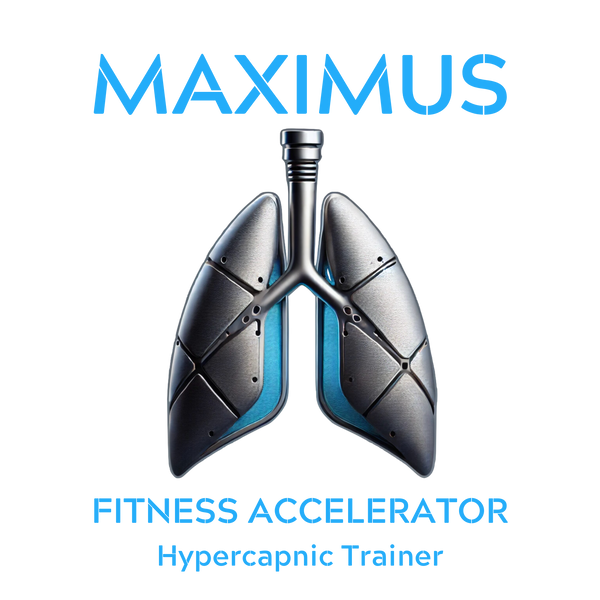
World's First Dual Airflow Resistance Hypercapnic Training Device Athletes and Elderly
Share
Blog Post Hypercapnic Training for Athletes and the Elderly
Unlocking the Power of Hypercapnic Training for Health and Longevity: In seeking optimal health and longevity, athletes and non-athletes continually seek innovative approaches to enhance physical performance and metabolic function. One such emerging method is hypercapnic training, which involves training under elevated carbon dioxide (CO₂) levels. While less mainstream than hypoxic training (low oxygen), hypercapnic training garners attention for its potential to improve VO₂ max, boost mitochondrial efficiency, and transform how the body utilizes lactate for fuel. Regardless of age, integrating hypercapnic training into your routine could be a promising step toward improved health and longevity.
The Role of CO₂ in the Body: CO₂ is not merely a waste product; it plays a crucial role in maintaining the body’s pH balance and regulating respiration. By increasing CO₂ levels during training, via resistance breathing device.
What Is Hypercapnic Training? Hypercapnic training involves deliberately increasing the levels of CO₂ in the body during exercise. This can be achieved through specific breathing techniques, rebreathing methods, or specialized equipment that elevates inhaled CO₂ levels. The fundamental idea is to expose the body to higher CO₂ concentrations than it typically encounters, prompting physiological adaptations that can enhance performance and metabolic health.
Understanding the Physiological Mechanisms: Hypercapnic training involves deliberately increasing the levels of CO₂ in the body during exercise. This can be achieved through various breathing techniques, rebreathing methods, or specialized equipment that elevates inhaled CO₂ levels. The fundamental idea is to expose the body to higher CO₂ concentrations than it typically encounters, prompting physiological adaptations that can enhance performance and metabolic health.
Enhanced Oxygen Release: The Bohr effect leads to more efficient oxygen unloading from hemoglobin to muscles.
Boosting VO₂ Max and Mitochondrial Efficiency: VO₂ max, or maximal oxygen uptake, is a crucial indicator of aerobic fitness. It represents the maximum rate at which the body can utilize oxygen during intense exercise. Here’s how hypercapnic training may contribute to increasing VO₂ max expiratory drive, encouraging more profound and efficient breathing patterns. This can improve oxygen delivery to the muscles during exercise.
Mitochondrial Biogenesis: Exposure to higher CO2 may induce mild metabolic stress, triggering the body to produce more mitochondria the cell's powerhouse. Increased mitochondrial density enhances the muscles ability to generate energy aerobically.
Metabolic Benefits of Increased CO₂ Levels: Regular exposure to elevated CO₂ can strengthen the body’s buffering systems, making it more adept at handling the metabolic byproducts of intense exercise.
Lactate Utilization: Higher CO₂ levels can lead to a more acidic environment in the muscles. This mild acidosis can encourage the body to become more efficient at clearing and utilizing lactate—a byproduct of anaerobic metabolism—as a fuel source. Improved lactate clearance delays the onset of fatigue and enhances endurance.
A Training Method for All Ages: One of the most compelling aspects of hypercapnic training is its accessibility. Regardless of age or fitness level, individuals can potentially reap the benefits:
Adaptable Intensity: Hypercapnic training can be adjusted to suit various fitness levels, from gentle breathing exercises to more intense physical activities.
Longevity and Health: Hypercapnic training may contribute to healthier aging and increased vitality by enhancing mitochondrial function and metabolic efficiency. VO2 Max is the most heavily weighted predictor of human mortality.
Consult a Professional: Before starting, discuss your plans with a healthcare provider or a certified trainer experienced in hypercapnic techniques.
Start Slowly: Begin with basic breathing exercises that gently increase CO₂ levels, monitoring how your body responds.
Monitor Your Health: Pay attention to how you feel during and after training sessions. Symptoms like dizziness or excessive shortness of breath indicate that adjustments are needed.
Conclusion: Hypercapnic training presents an intriguing avenue for enhancing physical performance and metabolic health. By potentially increasing VO₂ max, boosting mitochondrial efficiency, and improving lactate utilization, this training method offers benefits that can contribute to health and longevity at any age. As with any new training regimen, it’s essential to proceed with care, seek professional guidance, and listen to your body’s signals. Embracing hypercapnic training could be a step towards unlocking new levels of health and vitality on your journey toward optimal well-being.
References
- Bohr, C., Hasselbalch, K., & Krogh, A. (1904). Ueber einen in biologischer Beziehung wichtigen Einfluss, den die Kohlensäurespannung des Blutes auf dessen Sauerstoffbindung übt. Skandinavisches Archiv für Physiologie, 16(2), 402–412.
- Mickleborough, T. D., Stager, J. M., Chatham, K., Lindley, M. R., & Ionescu, A. A. (2008). Inspiratory flow resistive loading improves recreational runners' respiratory muscle function and endurance capacity. Respiratory Physiology & Neurobiology, 161(3), 259–266.
- Gladden, L. B., & Yates, J. W. (1997). Effects of prior exercise and recovery on net lactate uptake by canine skeletal muscle. Journal of Applied Physiology, 82(6), 1878–1885
Disclaimer: The information provided in this blog is for educational purposes only and is not a substitute for professional medical advice. Always consult a healthcare professional before starting any new exercise or training program.
